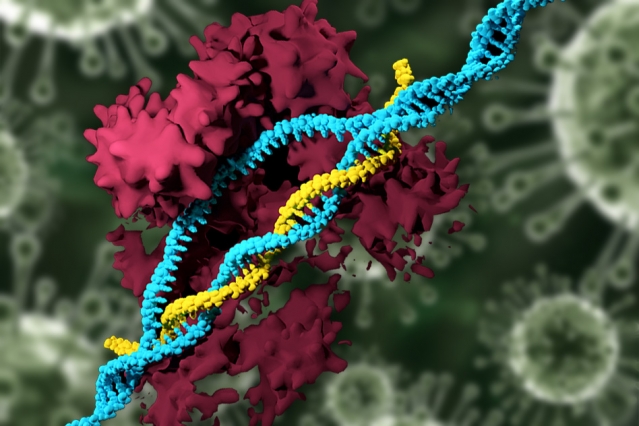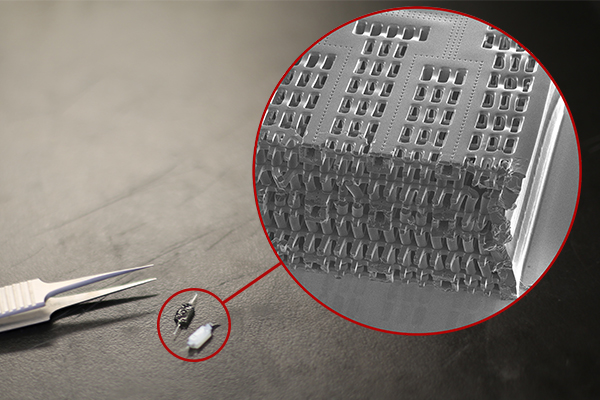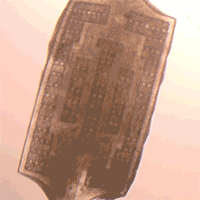Having included an explanation of CRISPR-CAS9 technology along with the news about the first US team to edit the germline and bits and pieces about ethics and a patent fight (part 1), this part hones in on the details of the work and worries about ‘designer babies’.
The interest flurry
I found three articles addressing the research and all three concur that despite some of the early reporting, this is not the beginning of a ‘designer baby’ generation.
First up was Nick Thieme in a July 28, 2017 article for Slate,
MIT Technology Review reported Thursday that a team of researchers from Portland, Oregon were the first team of U.S.-based scientists to successfully create a genetically modified human embryo. The researchers, led by Shoukhrat Mitalipov of Oregon Health and Science University, changed the DNA of—in MIT Technology Review’s words—“many tens” of genetically-diseased embryos by injecting the host egg with CRISPR, a DNA-based gene editing tool first discovered in bacteria, at the time of fertilization. CRISPR-Cas9, as the full editing system is called, allows scientists to change genes accurately and efficiently. As has happened with research elsewhere, the CRISPR-edited embryos weren’t implanted—they were kept sustained for only a couple of days.
In addition to being the first American team to complete this feat, the researchers also improved upon the work of the three Chinese research teams that beat them to editing embryos with CRISPR: Mitalipov’s team increased the proportion of embryonic cells that received the intended genetic changes, addressing an issue called “mosaicism,” which is when an embryo is comprised of cells with different genetic makeups. Increasing that proportion is essential to CRISPR work in eliminating inherited diseases, to ensure that the CRISPR therapy has the intended result. The Oregon team also reduced the number of genetic errors introduced by CRISPR, reducing the likelihood that a patient would develop cancer elsewhere in the body.
Separate from the scientific advancements, it’s a big deal that this work happened in a country with such intense politicization of embryo research. …
But there are a great number of obstacles between the current research and the future of genetically editing all children to be 12-foot-tall Einsteins.
…
Ed Yong in an Aug. 2, 2017 article for The Atlantic offered a comprehensive overview of the research and its implications (unusually for Yong, there seems to be mildly condescending note but it’s worth ignoring for the wealth of information in the article; Note: Links have been removed),
… the full details of the experiment, which are released today, show that the study is scientifically important but much less of a social inflection point than has been suggested. “This has been widely reported as the dawn of the era of the designer baby, making it probably the fifth or sixth time people have reported that dawn,” says Alta Charo, an expert on law and bioethics at the University of Wisconsin-Madison. “And it’s not.”
Given the persistent confusion around CRISPR and its implications, I’ve laid out exactly what the team did, and what it means.
Who did the experiments?
Shoukhrat Mitalipov is a Kazakhstani-born cell biologist with a history of breakthroughs—and controversy—in the stem cell field. He was the scientist to clone monkeys. He was the first to create human embryos by cloning adult cells—a move that could provide patients with an easy supply of personalized stem cells. He also pioneered a technique for creating embryos with genetic material from three biological parents, as a way of preventing a group of debilitating inherited diseases.
Although MIT Tech Review name-checked Mitalipov alone, the paper splits credit for the research between five collaborating teams—four based in the United States, and one in South Korea.
What did they actually do?
The project effectively began with an elevator conversation between Mitalipov and his colleague Sanjiv Kaul. Mitalipov explained that he wanted to use CRISPR to correct a disease-causing gene in human embryos, and was trying to figure out which disease to focus on. Kaul, a cardiologist, told him about hypertrophic cardiomyopathy (HCM)—an inherited heart disease that’s commonly caused by mutations in a gene called MYBPC3. HCM is surprisingly common, affecting 1 in 500 adults. Many of them lead normal lives, but in some, the walls of their hearts can thicken and suddenly fail. For that reason, HCM is the commonest cause of sudden death in athletes. “There really is no treatment,” says Kaul. “A number of drugs are being evaluated but they are all experimental,” and they merely treat the symptoms. The team wanted to prevent HCM entirely by removing the underlying mutation.
They collected sperm from a man with HCM and used CRISPR to change his mutant gene into its normal healthy version, while simultaneously using the sperm to fertilize eggs that had been donated by female volunteers. In this way, they created embryos that were completely free of the mutation. The procedure was effective, and avoided some of the critical problems that have plagued past attempts to use CRISPR in human embryos.
Wait, other human embryos have been edited before?
There have been three attempts in China. The first two—in 2015 and 2016—used non-viable embryos that could never have resulted in a live birth. The third—announced this March—was the first to use viable embryos that could theoretically have been implanted in a womb. All of these studies showed that CRISPR gene-editing, for all its hype, is still in its infancy.
The editing was imprecise. CRISPR is heralded for its precision, allowing scientists to edit particular genes of choice. But in practice, some of the Chinese researchers found worrying levels of off-target mutations, where CRISPR mistakenly cut other parts of the genome.
The editing was inefficient. The first Chinese team only managed to successfully edit a disease gene in 4 out of 86 embryos, and the second team fared even worse.
The editing was incomplete. Even in the successful cases, each embryo had a mix of modified and unmodified cells. This pattern, known as mosaicism, poses serious safety problems if gene-editing were ever to be used in practice. Doctors could end up implanting women with embryos that they thought were free of a disease-causing mutation, but were only partially free. The resulting person would still have many tissues and organs that carry those mutations, and might go on to develop symptoms.
What did the American team do differently?
The Chinese teams all used CRISPR to edit embryos at early stages of their development. By contrast, the Oregon researchers delivered the CRISPR components at the earliest possible point—minutes before fertilization. That neatly avoids the problem of mosaicism by ensuring that an embryo is edited from the very moment it is created. The team did this with 54 embryos and successfully edited the mutant MYBPC3 gene in 72 percent of them. In the other 28 percent, the editing didn’t work—a high failure rate, but far lower than in previous attempts. Better still, the team found no evidence of off-target mutations.
This is a big deal. Many scientists assumed that they’d have to do something more convoluted to avoid mosaicism. They’d have to collect a patient’s cells, which they’d revert into stem cells, which they’d use to make sperm or eggs, which they’d edit using CRISPR. “That’s a lot of extra steps, with more risks,” says Alta Charo. “If it’s possible to edit the embryo itself, that’s a real advance.” Perhaps for that reason, this is the first study to edit human embryos that was published in a top-tier scientific journal—Nature, which rejected some of the earlier Chinese papers.
Is this kind of research even legal?
Yes. In Western Europe, 15 countries out of 22 ban any attempts to change the human germ line—a term referring to sperm, eggs, and other cells that can transmit genetic information to future generations. No such stance exists in the United States but Congress has banned the Food and Drug Administration from considering research applications that make such modifications. Separately, federal agencies like the National Institutes of Health are banned from funding research that ultimately destroys human embryos. But the Oregon team used non-federal money from their institutions, and donations from several small non-profits. No taxpayer money went into their work. [emphasis mine]
Why would you want to edit embryos at all?
Partly to learn more about ourselves. By using CRISPR to manipulate the genes of embryos, scientists can learn more about the earliest stages of human development, and about problems like infertility and miscarriages. That’s why biologist Kathy Niakan from the Crick Institute in London recently secured a license from a British regulator to use CRISPR on human embryos.
…
Isn’t this a slippery slope toward making designer babies?
In terms of avoiding genetic diseases, it’s not conceptually different from PGD, which is already widely used. The bigger worry is that gene-editing could be used to make people stronger, smarter, or taller, paving the way for a new eugenics, and widening the already substantial gaps between the wealthy and poor. But many geneticists believe that such a future is fundamentally unlikely because complex traits like height and intelligence are the work of hundreds or thousands of genes, each of which have a tiny effect. The prospect of editing them all is implausible. And since genes are so thoroughly interconnected, it may be impossible to edit one particular trait without also affecting many others.
“There’s the worry that this could be used for enhancement, so society has to draw a line,” says Mitalipov. “But this is pretty complex technology and it wouldn’t be hard to regulate it.”
…
Does this discovery have any social importance at all?
“It’s not so much about designer babies as it is about geographical location,” says Charo. “It’s happening in the United States, and everything here around embryo research has high sensitivity.” She and others worry that the early report about the study, before the actual details were available for scrutiny, could lead to unnecessary panic. “Panic reactions often lead to panic-driven policy … which is usually bad policy,” wrote Greely [bioethicist Hank Greely].
…
As I understand it, despite the change in stance, there is no federal funding available for the research performed by Mitalipov and his team.
Finally, University College London (UCL) scientists Joyce Harper and Helen O’Neill wrote about CRISPR, the Oregon team’s work, and the possibilities in an Aug. 3, 2017 essay for The Conversation (Note: Links have been removed),
…
The genome editing tool used, CRISPR-Cas9, has transformed the field of biology in the short time since its discovery in that it not only promises, but delivers. CRISPR has surpassed all previous efforts to engineer cells and alter genomes at a fraction of the time and cost.
The technology, which works like molecular scissors to cut and paste DNA, is a natural defence system that bacteria use to fend off harmful infections. This system has the ability to recognise invading virus DNA, cut it and integrate this cut sequence into its own genome – allowing the bacterium to render itself immune to future infections of viruses with similar DNA. It is this ability to recognise and cut DNA that has allowed scientists to use it to target and edit specific DNA regions.
When this technology is applied to “germ cells” – the sperm and eggs – or embryos, it changes the germline. That means that any alterations made would be permanent and passed down to future generations. This makes it more ethically complex, but there are strict regulations around human germline genome editing, which is predominantly illegal. The UK received a licence in 2016 to carry out CRISPR on human embryos for research into early development. But edited embryos are not allowed to be inserted into the uterus and develop into a fetus in any country.
Germline genome editing came into the global spotlight when Chinese scientists announced in 2015 that they had used CRISPR to edit non-viable human embryos – cells that could never result in a live birth. They did this to modify the gene responsible for the blood disorder β-thalassaemia. While it was met with some success, it received a lot of criticism because of the premature use of this technology in human embryos. The results showed a high number of potentially dangerous, off-target mutations created in the procedure.
Impressive results
The new study, published in Nature, is different because it deals with viable human embryos and shows that the genome editing can be carried out safely – without creating harmful mutations. The team used CRISPR to correct a mutation in the gene MYBPC3, which accounts for approximately 40% of the myocardial disease hypertrophic cardiomyopathy. This is a dominant disease, so an affected individual only needs one abnormal copy of the gene to be affected.
The researchers used sperm from a patient carrying one copy of the MYBPC3 mutation to create 54 embryos. They edited them using CRISPR-Cas9 to correct the mutation. Without genome editing, approximately 50% of the embryos would carry the patients’ normal gene and 50% would carry his abnormal gene.
After genome editing, the aim would be for 100% of embryos to be normal. In the first round of the experiments, they found that 66.7% of embryos – 36 out of 54 – were normal after being injected with CRIPSR. Of the remaining 18 embryos, five had remained unchanged, suggesting editing had not worked. In 13 embryos, only a portion of cells had been edited.
The level of efficiency is affected by the type of CRISPR machinery used and, critically, the timing in which it is put into the embryo. The researchers therefore also tried injecting the sperm and the CRISPR-Cas9 complex into the egg at the same time, which resulted in more promising results. This was done for 75 mature donated human eggs using a common IVF technique called intracytoplasmic sperm injection. This time, impressively, 72.4% of embryos were normal as a result. The approach also lowered the number of embryos containing a mixture of edited and unedited cells (these embryos are called mosaics).
Finally, the team injected a further 22 embryos which were grown into blastocyst – a later stage of embryo development. These were sequenced and the researchers found that the editing had indeed worked. Importantly, they could show that the level of off-target mutations was low.
A brave new world?
So does this mean we finally have a cure for debilitating, heritable diseases? It’s important to remember that the study did not achieve a 100% success rate. Even the researchers themselves stress that further research is needed in order to fully understand the potential and limitations of the technique.
In our view, it is unlikely that genome editing would be used to treat the majority of inherited conditions anytime soon. We still can’t be sure how a child with a genetically altered genome will develop over a lifetime, so it seems unlikely that couples carrying a genetic disease would embark on gene editing rather than undergoing already available tests – such as preimplantation genetic diagnosis or prenatal diagnosis – where the embryos or fetus are tested for genetic faults.
…
-30-
As might be expected there is now a call for public discussion about the ethics about this kind of work. See Part 3.
For anyone who started in the middle of this series, here’s Part 1 featuring an introduction to the technology and some of the issues.


